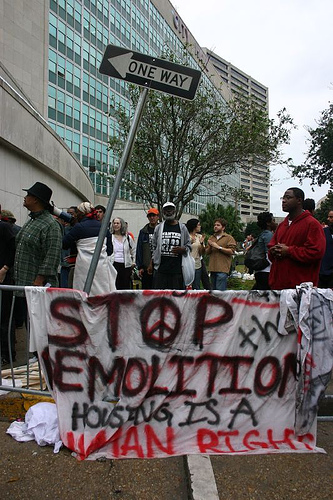hat tip, Beautiful Also Are The Souls of My Black Sisters:
Image description: several people surround a woman who is being tended to on the ground by two women and a man. The woman on the ground has her mouth open and appears to be crying out. There are various people running past and milling about–at least one appears to be holding a camera–media perhaps? In the background are metal police barricades and more people behind the barricade. (AP Photo/Cheryl Gerber)
New Orleans police officers subdue protesters at the New Orleans City Council meeting where the council is expected to vote for the demolition of housing projects in the city of New Orleans, Thursday, Dec. 20, 2007.
Image description: a large white cloth banner is draped over a metal police barricade. On the banner are the words STOP the DEMOLITIONS. HOUSING IS A HUMAN RIGHT. Several men, who are most certainly protesters, stand behind the barricade. In the background are New Orleans city buildings.
Police used chemical spray and stun guns Thursday as dozens of protesters seeking to halt the demolition of 4,500 public housing units tried to force their way through an iron gate at City Hall.
One woman was sprayed with chemicals and dragged from the gates. She was taken away on a stretcher by emergency officials. Before that, the woman was seen pouring water from a bottle into her eyes and weeping.
Another woman said she was stunned by officers, and still had what appeared to be a Taser wire hanging from her shirt.

Image description: a middle aged woman wearing a dark blue jacket with white stripes is lying on the grass. She appears to be weeping and in great distress. A man is behind her supporting her head, while a woman kneels in front of her with what appears to be gauze. This woman has been pepper sprayed, apparently directly in her eyes, and the man and woman with her are very probably rescue workers.
From the BBC:
New Orleans City Council has voted to demolish 4,500 public housing units despite violent protests against the development project earlier on Monday.
The US Department of Housing and Urban Development wants to replace the units, which were damaged by Hurricane Katrina in 2005, with new mixed-income housing.
But critics say the development will restrict the stock of cheap housing.
Earlier, police used pepper spray and stun guns on the protesters when they tried to get into the council chamber.
Several people were treated for the effects of the pepper spray. It is not known if any of the protesters were arrested.
Following hours of debate and clashes outside the meeting, New Orleans City Council voted in favour of the government’s plan to replace the decades-old structures damaged by Katrina to be demolished.
What the fuck was the City Council thinking? Money talks, folks. For some, money is the only thing they listen to. Shame, shame, shame.
Police in action:

Image description:Several cops in blue uniforms stand behind the iron gate that was used to lock protesters out of the City Council meeting. The third cop from the left is holding a can of pepper spray and spraying it out toward the crowd of protesters.
Ok, these are the poor black, brown, and white dispossessed residents of New Orleans fighting for their lives. Their lives. And a hearty “fuck you” and relegation to moderation to anybody who tries to justify what the Rich Men are doing to poor people down there.
While reading about the housing protests over the last couple of weeks, I keep thinking of something brownfemipower said in comments over at her place:
This might be a good conversation to have, not a lot of people recognize that there’s a difference between protesting and civil disobedience. Or that the u.s. hasn’t seen true civil disobedience since the 60’s and 70’s with the various power movements and the queer movement. Or the environmental movement that shut down nuclear facilities. I was going to talk about how we’re seeing the beginnings of some great movement making with youths, about how they shut down citibank recently, and about how the zapatistas shut down major freeways, and how the immolokee workers have won unprecedented victories through civil disobedience and cultural movement making—I was going to talk about all sorts of things, because I thought–well, let’s see if we can find a way to bring these worlds together.
This is important, because there is a cynical strain of thought out there that all that protesting and milling about and getting arrested is just a waste of time. Tell that to the woman with pepper spray in her eyes. Tell that to the cops. Tell that to the City Council, which was so rocked and intimidated by the power of angry people with a righteous cause that they had to hide behind an iron fence and police with weapons.
This is getting coverage all over the place, so I’ll just provide some links and let them tell the rest of the story:
For more great photo coverage
Is This What Democracy Looks Like?
Protesters clash with police over New Orleans demolitions
Common Ground Collective has been a great source for on the spot coverage
New Orleans Indy Media
The Redstar Perspective
*crossposted at Super Babymama